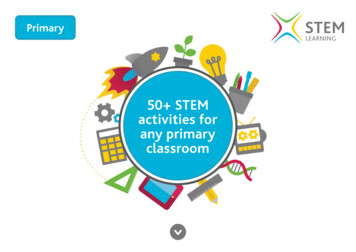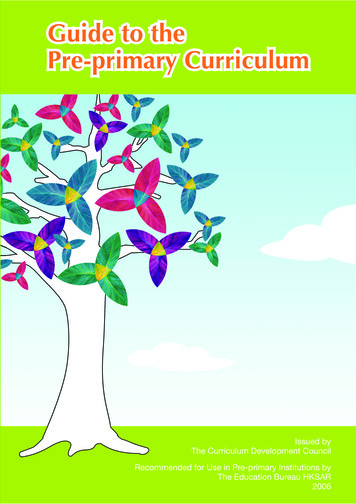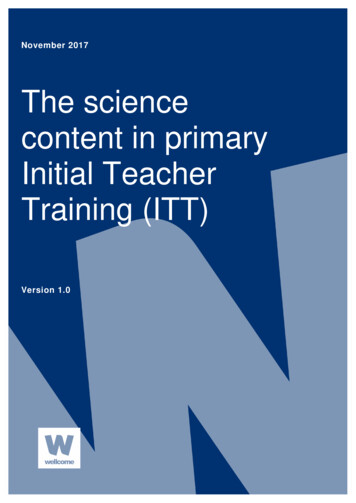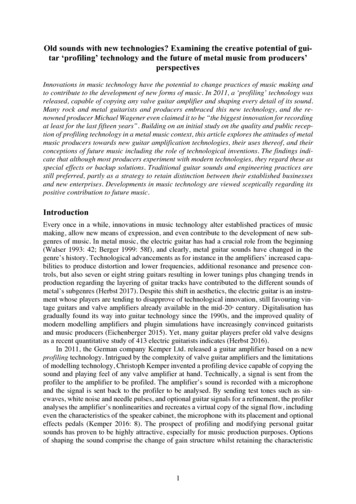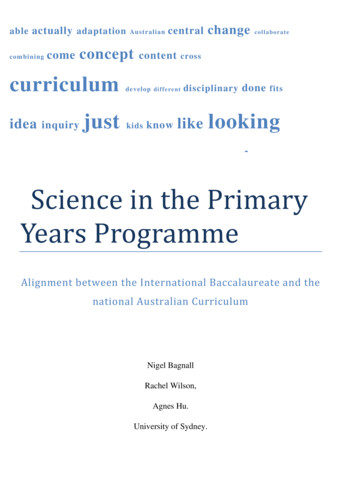
Transcription
able actually l ianinquiryjustcentralcontentknowco l la bo ra t ecrossdevelop dif f ere ntkidschangedisciplinary done fitslikelookingiScience in the PrimaryYears ProgrammeAlignment between the International Baccalaureate and thenational Australian CurriculumNigel BagnallRachel Wilson,Agnes Hu.University of Sydney.
Table of ContentsExecutive Summary . 4Introduction . 4The research approach . 5Chapter 1: Introduction and background . 7About the International Baccalaureate Organization . 7About the current study . 7Science in the Primary Years Programme . 8The importance of Science education . 9Research on the IB PYP . 9Research on the Australian Curriculum . 10Study Methodology . 12Chapter 2: Alignment between the IB PYP and AC Science curricula . 16Curriculum alignment mapping – content . 16Curriculum alignment mapping – skills . 29References . 38Appendices. 46Appendix 1: Curriculum alignment of knowledge and concepts . 46Appendix 2: Curriculum alignment of skills. 54Appendix 3: Science excerpts from the Review of the Australian Curriculum – final report. . 612
AcronymsACAustralian CurriculumACARAAustralian Curriculum Assessment and Reporting AuthorityAQFAustralian Qualifications FrameworkDPDiploma Programme of the International BaccalaureateIBInternational BaccalaureateIBCCInternational Baccalaureate Careers-Related CertificateMYPMiddle Years ProgrammePYPPrimary Years Programme3
Executive SummaryIntroductionThe increasing number of national and international schools offering the International BaccalaureatePrimary Years Programme (IB PYP) raises a number of questions relating to the structure of thecurriculum. How can schools from across the world offer the same curriculum? Is there any common corecontent that must be included within the PYP framework to satisfy the International Baccalaureate (IB)?Moreover, to what extent does the PYP align with curriculum requirements of national and local stateeducation systems?Recent changes within the Australian education sector have seen an attempt to unify all states andterritories within the same common curriculum framework. The Australian Curriculum, Assessmentand Reporting Authority (ACARA) have been charged with the task of co-ordinating a timely anduniform curriculum throughout all Australian schools. Presently, all States and Territories offerdifferent tertiary entrance qualifications and different systems of primary, middle and high schooleducation. A transition to providing a common national curriculum, the ‘Australian Curriculum’(AC), is presently underway and highlights how organisations such as the IB need to provideprogrammes that have the capacity work within national frameworks.The issues raised within Australia can also be found in other countries globally that are attempting toprovide an international dimension to their education system while maintaining their own unique andoften complex set of curriculum requirements. This study is an attempt to show if, and if so how,schools in a number of different Australian states have incorporated the requirements of the ACARAnational curriculum with that of the IB PYP framework, with a specific focus on science teaching andlearning.According to experts in the field (Bagnall, 2008, 2010, 2012, 2015; Cambridge & Thompson, 2004;Hayden & Thompson, 2000), the PYP can be regarded as a shelf curriculum. A shelf curriculumprovides a curriculum framework but not the content. It is more concerned with the method ofteaching than the content. Indeed, the IB Scope and Sequence document for PYP Scienceemphasises, “ the science contained within the PYP is characterized more by concepts andskills rather than by content” (IB, 2008, p. 1). The IB views science at the primary years as atransdisciplinary programme exploring the biological, chemical and physical aspects of the naturalworld and the relationships between them. The IB offers a sample programme of science inquiry butdoes not insist that it is mandatory for schools. In fact the IB acknowledges that “Some schools mayneed to reflect national, regional or local requirements within the units of inquiry that are developedand included in their programme of inquiry” (IB, 2008, p. 2).4
In conclusion, this study is concerned with the way that Australian schools offering the IB PYPincorporate the requirements of the Australian Curriculum with the guidelines for science teachingand learning provided by IB for the PYP programme.The research approachThe design of this study has two principle elements within it. There is a comparative curriculumanalysis and an analysis of curriculum implementation. The comparative curriculum analysis,undertaken to address Research Questions 1 and 2, utilised both document analyses and interviewsthat helped clarify, analyse and report on the relationship between the IB PYP Science and theAustralian Curriculum Science learning area. The curriculum implementation study, focusing onResearch Questions 3 and 4, drew on interviews with PYP Co-ordinators, primary school principalsand classroom teachers and observation of classroom practice. Readers should note that this reportprovides findings solely with regards to the comparative curriculum analysis called for by ResearchQuestions 1 and 2, which are listed below.RESEARCH QUESTIONSCurriculum alignment:1.In what ways does the science component of the PYP support the knowledge, concepts, skillsand processes that you are expected to teach and students are expected to learn to meet theAustralian Curriculum: Science content descriptions?2.To what extent does science teaching and learning in the PYP support students to fulfill thegeneral capabilities and cross curriculum priorities of the Australian Curriculum?School implementation practices:3.How do Australian IB World schools design and implement programs of inquiry, PYPplanners and Science Scope and Sequence in ways that address the content and achievementstandards of the Australian Curriculum: Science learning area?4.What practices and factors contribute or impede the successful alignment of the sciencecomponent of the PYP and the Australian Curriculum?Curriculum analysis is required periodically in all education systems (Oates, 2011) so thatimprovements can be made. Such analysis helps identify the strengths and weaknesses of thecurricular design. Levander and Mikkola (2009) pointed to the need to examine both the breadth anddepth of content coverage as well as pedagogic aspects within curricula. The findings presented in thisstudy therefore provide a valuable resource for those interested in the adoption of an internationalcurriculum, like the IB PYP, that can retain a national focus within the curriculum.5
The major results of this study are: there are no major obstacles for individual Australian primary schools to incorporate thescience teaching and learning requirements of the International Baccalaureate Primary YearsProgram with that of the Foundation to Year 6 Science requirements of the AustralianCurriculum. although there are substantial differences in terms of content, mostly in relation to the largesize of the content covered in Australian Curriculum, the PYP Science and AustralianCurriculum Science learning area are fairly neatly aligned in terms of the skills they developwith students.6
Chapter 1: Introduction and backgroundAbout the International Baccalaureate OrganizationThe commodification of education that ensued partially as a result of the school choice movement inthe later part of the 20th century has seen a proliferation of education systems and programmesavailable to national education providers. The International Baccalaureate (IB) provides one of themost successful curriculum models available for those schools interested in offering an internationaleducation choice for their student body. The IB is a not-for-profit educational foundation, motivatedby its mission to develop inquiring, knowledgeable and caring young people who help create abetter and more peaceful world through intercultural understanding and respect. The organizationhas built a reputation for quality, high standards and pedagogical leadership in the field ofinternational education, encouraging students across the world to become engaged world citizenswho are active, compassionate and lifelong learners (IB, 2015).Founded in 1968 the IB has flourished in both the number of students and schools participating in theorganisation’s four programmes. The Diploma Programme, the first to be developed by the IB, wasoriginally established to provide an entry-level qualification suitable for students studying in a widerange of international schools. The programme has increasingly appealed to national private and stateschools wishing to provide an international focus to their students. The early years of the IB Diploma(1970-75) saw a significant interest in international schools in Europe and North America, completingthe Diploma. A number of state schools, especially in the United States and Canada began taking theIB DP as an alternative to their own matriculation system. The IB currently works with 4000 schoolsin 147 countries to develop and offer four programs to over 1,235,000 students aged 3 to 19 years.The organization also provides professional development workshops for more than 60,000 teachersand administrators annually (IB, 2008). In 1994 the IB introduced the Middle Years Programme(MYP) and then in 1997 the Primary Years Programme (PYP). The most recent InternationalBaccalaureate programme, the IB Career-related Programme (IBCP), was introduced in 2012.As has been noted, globally, increasing numbers of international and national schools have chosen toadopt internationally accepted education programmes and qualifications alongside, or instead of, thelocal qualifications and curricula. According to Cambridge & Thompson, curriculum that empowersyoung people for “ international understanding and peace, responsible world citizenship and service[ ] makes sound educational sense” (2004, p. 172). IB programmes offer one such approach.About the current studyOver the past decade IB programmes across the world have grown substantially. Current projectionspredict 10,000 authorized schools and 2 million IB students by the year 2020. To support the growth7
and development of the organization’s programs, the IB Research Department commissions studiesthat seek to identify the impact and value of an IB education. As part of this agenda, this projectexamined the extent to which the IB Primary Years Programme enables students to learn curriculumcontent (knowledge, skills and understandings), and meet achievement standards for Years 3-6 of theAustralian Curriculum: Science.Australia has consistently been one of the most interested countries globally to adopt the IB alongsidecurriculum offered by Australian states and territories. The first school to adopt the IB Diploma in1979 was a state school and while the majority of schools choosing the IB have since been privateschools, the growth in popularity has continued throughout both the state and private sector.Science in the Primary Years ProgrammeThe IB PYP is designed for students aged approximately 3-12 years of age. It regards the student asan inquirer both within the classroom and beyond. The approach of the PYP is transdisciplinary andattempts to offer a challenging program to motivate both students and teachers alike. There are a totalof six subject areas: Language; Mathematics; Science; Social Studies; Arts and; Personal, Social andPhysical Education. The subject that is the focus of this study, Science, is intended to give students anappreciation and awareness of the world through a lens provided by a scientific stance. The scientificapproach promoted by the PYP is characterised by a combination of concepts and skills with abreadth and balance of science content. These are contained within the units of inquiry that are madeup of themes such as ‘How the world works’ and information relating to them may be found in the IBPrimary Years Programme publication – ‘Science Scope and Sequence’ document.The Science Scope and Sequence document views the exploration of the relationship between “ thebiological, chemical and physical aspects of the natural world ” (IB, 2008, p. 1) as one of the mostsignificant elements of the programme. Viewing the world from a scientific perspective enablesstudents to develop an understanding of the world. According to the IB, “Reflection on scientificknowledge also helps students to develop a sense of responsibility regarding the impact of theiractions on themselves, others and their world” (IB, 2008, p. 1).It is clearly stated in the introduction of the Science Scope and Sequence document that merelyteaching and learning about Science as a subject is not the sole expectation of the PYP programme.Rather, it is the exploration of the connection between Science and other subjects that provides atransdisciplinary approach. Indeed, according to IB, “The transdisciplinary themes provide theframework for a highly defined, focused, in-depth programme of inquiry, and as science is relevant toall the transdisciplinary themes, all planned science learning should take place within this framework”(IBO, 2008, p. 1).8
The importance of Science educationThe importance of science education in developing educational and economic capital is emphasised innumerous government, industry and academic reviews. In Australia, the critical role of scienceeducation has been highlighted recently in the 2012 Chubb paper on the position of Mathematics,Engineering and Science in the national interest (Chubb, 2012). Chubb’s findings are aligned withinternational perspectives outlined in a report by Rocard et al. (2007), produced for the EuropeanCommission, which firmly places the provision of Maths, Engineering and Science as importantfactors in the establishment of high technology fields within Europe. The Chubb paper notes thatAmerica’s position of economic advantage is predominantly as a result of its scientific innovation thathas produced roughly half of all economic growth in the last 50 years.The Science, Technology, Engineering and Mathematics (STEM) fields and those who work in themare critical engines of innovation and growth. According to one recent estimate, while only about fivepercent of the U.S. workforce is employed in STEMS fields, the STEM workforce accounts for morethan fifty percent of the nation’s sustained economic growth. (U.S. Department of Labor, 2007).It could be argued that the beginning of any emphasis on the development of interest in Science,Mathematics and Engineering should begin at the primary school level. However, there is littleresearch that has been focused on curriculum design and implementation within this area in Australia,hence the significance of the study presented here.Research on the IB PYPThe research literature relating to the IB PYP is contained in a number of sources. The most recentstudy in Australia of Science in the PYP (Campbell, Chittleborough, Jobling, Tytler, & Doig, 2014)looks at the science literacy of a number of Australian PYP schools and was undertaken by a team ofacademics at Deakin University. The study, entitled Science literacy in the InternationalBaccalaureate Primary Years Programme (PYP): NAP-SL outcomes, drew on a sample of ten schoolswith a mix of urban, rural, government and non-government schools. The aim of the study was toevaluate the science literacy of students undertaking the IB PYP programme in a selection ofAustralian schools. These levels of attainment were then analysed and compared with the results ofNational benchmark tests within Australia, namely NAP-SL 2012 results. Comparisons were madewith five science proficiency levels that have been adopted by the NAP-SL. Further comparisons weremade between Australian NAP-SL results for female and male students with outcomes achieved bystudents taking the IB PYP from both government and non-government schools. Given the design ofthe study, it was difficult to say what caused the higher level of proficiency of the IB PYP cohort,83.3% above the suggested proficiency level of 3.2 compared with 51.4% for national students.Caveats to the results of this study included that only two government PYP schools took part in the9
research, and the inclusion of a smaller number of female participants made reliable comparisonsbetween PYP boys and girls problematic.There are a number of studies that relate to various aspects of the IB PYP, without explicit focus onscience that may be found at the IB Research Department website 1. These include an Australian study(2014) in Victorian Government schools offering the PYP. Another study published in 2014 on earlychildhood education looked at two schools in Melbourne and two schools in Singapore. A major 2013study in India looked at the impact of the PYP in various parts of India. An earlier 2010 study lookedat the implementation of IB PYP and MYP programs in Texas State schools. It found that IB schoolsperformed as well as their non-IB comparison schools in Mathematics and Reading. Classroomobservations found favourable instructional practices took place more often in IB classrooms thannon-IB Texas classrooms. They found there were several challenges facing both teachers andadministrators of these schools. These included such things as finding suitably qualified IB staff,covering both Texas State and district requirements alongside those of the IB requirements. They alsofound that additional time was needed for collaborative lesson planning and paper work.Research on the Australian CurriculumIn August 2014 a major Australian government sponsored report, Review of the AustralianCurriculum, undertaken by Kevin Donnelly and Kenneth Wiltshire, was released to the public(Donnelly & Wiltshire, 2014) 2. The review was initiated by an incumbent Liberal government,whereas a previous Labor government had implemented both ACARA and the development of theAustralian Curriculum. Donnelly & Wiltshire’s report was the result of a comprehensive study thatcollected feedback from major stakeholders throughout Australia. In total there were over 1600submissions from individuals, the general public and a wide range of international research andcommissioned reports that were drawn on for the review. The final report made 30 recommendationsto the government to strengthen the Australian Curriculum. The significant findings for the purposesof this study were that there was too much curriculum content required by the AC, and this was notedto be particularly the case in the primary school years. Other findings were that: aspects of the ACmade teaching too complicated and required reconsideration; and further; some stakeholders felt thatparents were locked out of the schooling process whereas they wanted to be more closely involved inthe learning process of their children. Donnelly & Wiltshire additionally recommended that the ACneeded to be inclusive of all students, including those with disabilities. The report suggested that theAC should develop a vision statement to guide future developmental changes. There was a wide range1The IB Research Department website can be accessed at the following address, http://www.ibo.org/en/aboutthe-ib/research/.2The 294 page document may be found at the following address, 0
of views also given regarding the role, function and power that was provided to the ACARA, theorganisation responsible for creating and overseeing the Australian Curriculum.The Australian government’s response to the review was based around a number of central themes.The first of these themes concerned overcrowding in the current curriculum. The government feltthere was a general consensus that all areas of the curriculum, including primary, middle andsecondary years, were too content heavy. The government singled out the primary school curriculumas most significantly affected by this issue, and indicated this should be addressed as a matter ofpriority.Other areas that the government identified as needing to be addressed focused on parentalinvolvement, access for all students, and rebalancing of the curriculum to ensure that meaningfullearning takes place with no gaps in what areas are taught. A special mention was made on the needfor an increased emphasis on phonics in early years reading. There was little specific focus on primaryscience in the overall recommendations.The Review of the Australian Curriculum findings regarding the Science key learning area of the ACare included in Appendix 3 of our report. The Review recommended that the Foundation to 10Science curriculum be reconsidered in relation to:1. the need to focus on depth by reducing the content and coverage of the science curriculum forFoundation to Year 102. The cross-curriculum priorities should be removed from the science curriculum and not all theinterrelated strands should be given equal prominence and weight across the various stages ofschooling3. “A better balance should be sought between a constructivist and an explicit teachingpedagogical approach to classroom practice” (Australian Government, 2014, p. 187).These Science curriculum recommendations and the more general recommendation of the AC reviewwere at the time of writing being considered by state and commonwealth governments and there wasno clear indication as to whether they will be followed. However, the above findings provide someinsight into the issues that arise in implementation of the AC Foundation (Year F) to Year 7 Science.11
Study MethodologyResearch ObjectivesThe goal of the current project was to explore the alignment of the Science component of the PrimaryYears Program with the aims, content and achievement standards of Years 3-6 of the AustralianCurriculum: Science administered by the Australian Curriculum Assessment and Reporting Authority.Consisting of three phases, the study first used mapping techniques to explore areas ofcomplementarity and difference between Science in the PYP and the Australian Curriculum Sciencelearning area. Next, the study investigated the extent to which Australian IB World Schools perceivethe PYP curriculum framework as supporting the i) three Science content strands, ii) generalcapabilities, and iii) cross-curriculum priorities of the Australian Curriculum. The final aspect of theresearch identified implementation approaches that schools found successfully fulfilling the principlesand practices of the Primary Years Programme and the aims and requirements of the AustralianCurriculum: Science. As was noted earlier, this document provides findings solely with regards to thecomparative curriculum analysis called for by research questions 1 and 2 below.Research QuestionsThe following four research questions have been addressed in this study. The first two address issuesof curriculum alignment.1. In what ways does the science component of the PYP support the knowledge, concepts, skillsand processes that teachers are expected to teach and students are expected to learn to meetAustralian Curriculum: Science content descriptions?2. To what extent does science teaching and learning in the PYP support students to fulfill thegeneral capabilities and cross-curriculum priorities of the Australian Curriculum?The last two enquire about school implementation practices.3. How do Australian IB World Schools design and implement their Programme of Inquiry,PYP planners and Science Scope and Sequence in ways that address the content andachievement standards of the Australian Curriculum Science learning area?4. What do schools identify as factors and practices that impede or contribute to the successfulalignment of the science component of the Primary Years Programme and AustralianCurriculum: Science?Table 1 (p. 15) shows how the research questions were addressed, including the proposedmethodological design, relevant data and planned analyses. The study consisted of a comparativedocument analyses and interviews with a range of school staff and administrators to provide12
additional data to answer the research questions. The researchers would like to thank all those schoolsand teachers for their input and participation in this study.Design and participantsThis study is a comparative curriculum analysis utilising both document analysis and interviews thataim to synthesise, analyse and report on the relationship between the Australian Curriculum Sciencelearning area and IB PYP Science. In total, four schools participated in the study. There were two inQueensland, one in Victoria and one in New South Wales. Interviews were conducted with 12participants, which included schools administrators and PYP co-ordinators and a number of primaryschool teachers at each school. The funding for the project was limited and did not enable a biggersample from across all states and territories of Australia. Two of the schools were private schools andtwo were state schools. One of the schools was in a rural location but was not in a remote area ofAustralia.Table 1 over the page, shows the summary of the research questions and the study design.13
Table 1Research Questions and Study DesignResearch QuestionsDataAnalysis and reportingCurriculum alignmentDocuments: The IB PYP: PYP Science Scope and Sequence (2008); Scienceacross the IB continuum (2011); Making the PYP happen: A curriculumframework for international primary education (2009); Making the PYP happen:Pedagogical leadership in a PYP school (2009); The Primary Years Programme:A basis for practice (2009) ACARA: The Shape of the Australian CurriculumVersion 2.0 (2010); Australian Curriculum: Science (2011)Alignment will be examined and discussed in a summativeway through comparative tables (summative in the report detailed in appendices) produced from content analysis of thedocuments.1.2.In what ways does the science component ofthe PYP support the knowledge, concepts,skills and processes that teachers are expectedto teach and students are expected to learn tomeet Australian Curriculum: Science contentdescriptions?To what extent does science teaching andlearning in the PYP support students to fulfilthe general capabilities and cross-curriculumpriorities of the Australian Curriculum?The above is supplemented by an account of important pointsof clarification provided from interviews.Interviews: Interviews with IB and ACARA staff (science curriculum writersand teachers), will be used to clarify issues that are apparent in practice nottransparent in documents.Documents: The IB PYP: PYP Science Scope and Sequence (2008); Scienceacross the IB continuum (2011); Making the PYP happen: A curriculumframework for international primary education (2009); Making the PYP happen:Pedagogical leadership in a PYP school (2009); The Primary Years Programme:A basis for practice (2009). ACARA: The Shape of the Australian CurriculumVersion 2.0 (2010); Australian Curriculum: Science (2011)This analysis summarises the cross-curriculum approaches inPYP and AC. Comparative tables (detailed summative)which have been produced from the content analysis of thedocuments.Analysis of the IB teachers’ interviews complements the aboveanalysis.Interviews: with IB PYP Science teachers, will be used to clarify issues that areapparent in practice not transparent in documents.School implementation practices3.4.How do Australian IB World schools designand implement their programme of inquiry,PYP planners and science scope and sequencein ways that address the content andachievement standards of the AustralianCurriculum Science learning area?What do schools identify as factors andpractices that impede or contribute to thesuccessful alignment of the science componentof the Primary Years Programme andAustralian Curriculum: Science?Interviews: Interviews with IB Science teachers will be used to explore issues inimplementation and report on strategies employed in successful teaching andlearning.Interview transcripts have b
The Science Scope and Sequence document views the exploration of the relationship between “ the biological, chemical and physical aspects of the natural world ” (IB, 2008, p. 1) as one of the most significant elements of the programme. Viewing the world from a scientific perspective enables students to develop an understanding of the world.File Size: 1MB



